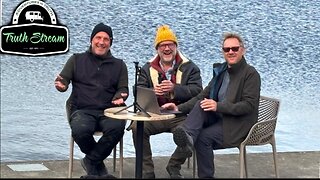Premium Only Content

Apollo 14 rocks Summer Slump!
Yo, Sludge Squad! The summer slump’s full of Epstein rumors, but Brontius 2.0 and Major Tom bring the heat with Apollo 14! Alan Shepard lands Fra Mauro like a boss, survives two heart-stopping glitches, and shaves for style before splashdown. 95 lbs of moon rocks prove it’s no fake! Join the fight for science with Terabyte bots and Epicotechurch’s Jesus vibe. #SludgeParty #Apollo14
[English, French, German in Madeleine font]
--
Factual Appendix: Apollo 13, Follow-Up Missions, and Moon Rock Analyses Apollo 13 (April 1970): Disaster: "Houston, we've had a problem!" An oxygen tank exploded, and the moon landing was aborted. Jim Lovell, Jack Swigert, and Fred Haise fought for 87 hours to survive, used the lunar gravity to return, and landed safely in the Pacific. Heart attack moment: The CO₂ filters had to be improvised ("Square peg, round hole!").
Impact: Apollo 14 was pimped up with safety fixes (e.g., improved tanks, better docking mechanics). NASA demonstrated resilience—not a fake, but hard engineering!
Follow-up Missions: Apollo 15 (July 1971): First use of the Lunar Rover. David Scott and James Irwin explored Hadley Rille and collected 77 kg of rock.
Apollo 16 (April 1972): John Young and Charles Duke in the Descartes Highlands, 95.7 kg of rock. Rover action and jump records!
Apollo 17 (December 1972): Last lunar landing. Eugene Cernan and Harrison Schmitt (geologist!) collected 111 kg in the Taurus-Littrow Valley. Record: 22 hours of extravehicular activity.
Total: Six lunar landings (Apollo 11, 12, 14, 15, 16, 17), 382 kg of rock, 2,200 samples. Apollo 13 was the only abort.
Lunar rock analyses: Composition: Apollo 14's Fra Mauro rock contained breccias (fragmentary rocks) with high potassium and uranium contents, 10 times higher than Apollo 11/12 samples. Age: 3.8–4.5 billion years, confirmed by radiometry (e.g., uranium-lead dating).
Findings: Moon formation: Theia collision theory supported – Moon formed from Earth's mantle material after a primordial impact.
Crust: Fra Mauro's rocks come from a depth of 60 miles (Imbrian Basin) and show early magma oceans.
Earth-Moon system: Similar isotope ratios (e.g., oxygen) indicate a common origin.
Meteorites: Craters like Cone Crater provided material from the lunar crust, unlike volcanic maria samples.
Proof against fake: Laser reflectors: Apollo 14's reflector still measures the distance to the Moon (e.g., via the McDonald Observatory, ±2 cm).
Seismometer: Apollo 14's instrument recorded moonquakes and booster impacts, collecting data up to 1977.
Samples: 382 kg of lunar rocks were analyzed by thousands of geologists worldwide (e.g., MIT, Max Planck Institute). No other terrestrial material resembles the anorthositic crust or the missing-water profile.
Apollo 14 rocks Summer Slump! with an analysis by Grok3...
-
 8:11
8:11
MattMorseTV
14 hours ago $3.31 earnedTrump's DECLARATION of WAR.
6.45K44 -
 3:44
3:44
GritsGG
13 hours agoUpdate Your Warzone Loadouts w/ These Tips!
9391 -
 2:31:01
2:31:01
The Connect: With Johnny Mitchell
15 hours ago $1.28 earned"It's About To Get Worse"- CIA Agent Andrew Bustamante Explains Why It's Time To Leave America
2.24K9 -
 36:28
36:28
TruthStream with Joe and Scott
1 day agoMark Attwood joins TruthStream in Ireland!
4.87K30 -
 2:13:30
2:13:30
Side Scrollers Podcast
1 day agoUK Introduces MANDATORY Digital ID + Dallas ICE Shooting BLAMED on Gaming + More | Side Scrollers
189K50 -
 LIVE
LIVE
Lofi Girl
2 years agoSynthwave Radio 🌌 - beats to chill/game to
155 watching -
 2:26:44
2:26:44
Tundra Tactical
7 hours ago $9.97 earned🎉 Pro-2A Party LIVE! | Zeke Stout Joins The Show With Tacoma Tactical
15.5K -
 2:36:47
2:36:47
BlackDiamondGunsandGear
9 hours agoAFTER HOURS ARMORY / The LEFT are Recruiting / Join the Leftist Gun Club?
7.13K8 -
 16:07
16:07
Ken LaCorte: Elephants in Rooms
13 hours ago $2.84 earnedWhy firefighting got political
12.6K4 -
 8:31
8:31
Rethinking the Dollar
17 hours agoBitcoin Secrets Nobody Talks About!
7.51K5